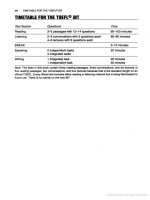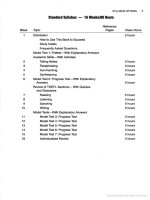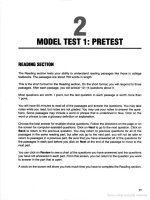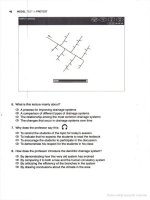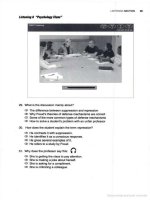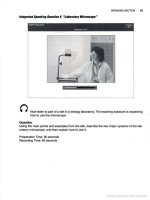Toefl ibt internet based test 2006 - 2007 part 38 pdf
Bạn đang xem bản rút gọn của tài liệu. Xem và tải ngay bản đầy đủ của tài liệu tại đây (1012.71 KB, 7 trang )
SPEAKING
2:S3
STUDYPW
Whardid you learn
from
taking
the
quiz? What
wilt
you
do
dinerenUy
when
you
take the model
tests
in
the
next
chapter?
Take
a
few
minutes to
th
ink
and
then
write a sentence or
two
to help
you revise your study plan.
EXTRA
CREDIT
After
you
have completed this chapter,
you
may
want to continue a review
01
speaking.
Here
are
some
suggestions.
Usten
to
good
models
of
speaking In
similar
situations. Research Is dearty
on
the
side of those
whO
advocate listenirlQ as a method to Improve speaking. This means that one of
the best ways to
learn to speak
well
is to listen to good speakers. " is also important to simu-
late the kind of
speaJdrlQ
situation that
you
will
be
required to complete.
On
the TOEFL,
you
have six questions and six situations. If you ask similar questions to excellent speakers
and
lis-
ten carefutly to their responses,
you
will learn a great deal. That is why this book
contains
recorded examples of the answers
that
excellent speakers might provide
fOf
~
questions in
th
is review chapter and in
the
Speaki
ng
section of each
model
test. For extra credit and
improvement,
ask
teachers
Of
English-speakirlQ friends to record their answers to the Speak-
irlQ
questions
in
th
is book.
Oon'
give them the questions in advance.
Use
the same presenta-
tion
and
liming that you afe using for the model tests.
Then
listen to their answers.
Practice
using
the
telephone
to
speak
Gall
a
friend
to
prat1ice
some
01
the
speaking
ques-
tions by phooe.
Speak
directly into the phooe. Ask
your
friend
to
conmn
that
you
are
speaking at
a
good
volume
to
be
heard
clearly
and
that you soond confident, but not arTOgant.
If
your
friend
is
a native
speaker
,
you
can
ask
some
01
the
Speaking
questions and listen
to
the
responses.
Some
telephones
have
a recording option. With your
friend
's permission, you
can
record
the
call.
OPTIONS
FOR
EVAlUATlOII
II
is
di
ffICUlt
to evaluate your
own
speaking.
II
you
are taking
an
Eng
lish ctass, ask your teacher
to
use
the checklists
in
th
is chapter to evaluate your
speaking
.
You
need to
know
how
you
are
progressing
in
relationShip to the criteria
on
the checklists because that is
how
you
will
be
eval-
uated
on
the TO
EFL
i8
T.
If
you do
not
have
good
options to have your
speaking
evaluated without a
fee
, there
is
a
fee-based option that will provide professional evaluations. See page 781 lor details.
A~VISOR'S
OFFICE
When you lace a challeoge, "fake it until
you
can make
it:
This means that
you
should act
as
though everything were
wor1<ing
out
wei!,
even when you have
doubts. Put a smile
on
your face, even if it
isn'
real
, and eve
nt
ually it will
be
a
re
al
smile. Stand
up
straight
with
your head high
and
walk w
ith
purpose.
You
will start to
actually
foollT'lOfe
confident.
II
you are acting li
ke
a successful person, it may fool
strange at first.
But
the more you practice your
role
as
a successful person, the
more comfortable you will be. Soon, when you reach your goals and you are truly
successful, you will have practiced the
role,
and you will
be
the person you have
been playing.
"
oc,
."
254
REVIEW
OF TOEFl.
IBT
SECTIONS
WRITING
OVERVIEW
OF
THE
warnE
SECTION
The Writi
ng
section tests your ability to write essays
in
English similar to those that
you
would
write
In
college courses.
During the test,
you will write
two
essays. The integrated essay asks
for
your response to
an
academic reading passage
and
a
IecttJre
on
the same topic.
You
may take notes as you read
and
listen,
but
notes are
not
graded.
You
may use your notes to write the
essay.
The
lecture
will
be spoken, but the directions
and
the questions will be written.
You
will
have
20
minutes
to
plan, write,
and
revise
yo
ur response. Typically, a good essay for the integrated topic will
require that
you
write 1
50-225
word
s.
The
independent essay usually asks lor your opinion about a familiar topic.
You
will have 30
minutes to
plan
, write,
and
revise your response. Typically, a good essay lor the independent
topic will
requ
ire
that
you
write
300-350
words.
A clock
on
the screen will
show
you how much time
you
have to complete each essay.
REVIEW
OF
PROBlEMS
FOR
THE
WArnNG
SECTION
~
Prompts
A prompt
for
the Writing section is either a question that refers to both a spoken and written
text lor the integrat
ed
es
say
or
a written question lor the Independent
essay.
Problems 31-34
in this review reler to the kind
01
prompts that are typical on the TOEFL. On the official
TOEFL
~
iBT,
you
will be asked to respond to one integrated question and one independent
question. The scripts lor the spoken prompts have
been
printed lor
you
to study while
you
lis-
ten 10 them.
On
the official TOEFL-
19
T,
you
will not
see
the spoken prompt.
You
will
see
the
wrmen
questi
on
and textbook passage.
,
Problems
The
problems
in
this review represent the types
of
questions that are
most
frequently tested
on
the
TOEFL. The task for each problem
Is
explained. Each problem appears
as
one
01
the
two
questions
included
in
the Writing section.
In
this integrated essay question,
you
wilt
be esked to read a short passage from a textbook
and
then listen
to
part of a short lecture about
the
same topic. The Ideas
In
the lextlXlok
and
the
lecture
will
nol agree. After you
read
the
question, you write
an
essay that Includes info
r-
mation from both the reading
and
the lecture.
M
til
chr,
~y,'
k
prAY\!
WRITING
2S5
You
will have
20
minutes
to
plan, write,
and
revise your essay. Typically, a good response will
require that
you
write
150-225
words.
Task
• Read a short passage
and
take notes
• Listen to a soon lecture
and
take notes
• Answer a question using Information from both the reading
and
the lecture
Readi
ng
Passage
Time: 3 minutes
In his classic book The
published
in
U -3
as the _ of many For
is
coocemed about taking an Important
",.,",
a~,.rt';,exam
,
or
, more tikely,
some
type of _
'or
the
exam '
II
appear in a dream. Since thoughts must
be
translated into concrete images,
•
fi
n _ rather than in words. Freud advanced the
,
~L"
oase of
"'
that Is, _
with
the
might
be
expressed as
an
muCh
is
case of
the wish
to
be
-
'0'1"
. .
. - , . -
In some way,
and
forces
that oppose it. In the
they offer a compromise, that Is, a
way
for
to Freud,
can be viewed
as
a
way
to _
that
encl
, there
are
to
every dream, including the
w',;a, is and the which is
To
return to the example of the student's dream,
the
manifest coolent
would
be
the in the race, but
the
latent content would
be
the _ that
is
In
the
dreamer's subconscious. Because
and
desires are •
MfUti!iiiilOf too socially to surface from the unconscious to the
conscious
mind
, the symbolS that are employed may make the wish
diflicullto
expose,
The
student may actually want to cheat in order to succeed
on
the
exam,
but
In
a dream,
borrowing
a friend's book may
be
a more acceptable way
to express that
desire. In a sense, the serves to
iiIiifIIin
the unconsdous,
Reading
Passage
Notes
Freud 1900 Iol
em
Dreams
• wish fulfi
ll
ment
+-
d
• student d exam
or
symbol
• d = pictures
11
words
• symbols images
• exam::: obstacle in race
, !
256
REVIEW
OF
TO
E
Fl
- ieT S
ECTION
S
D = daydreams
• wish repressed
• d sale express
• d reveal unconscious
2 levels
,.
manifest contenl '" obvious, direcllobstacie race
latent content
= symbolic/exam
•
wishes disturtllng
or
Inapprop
• symbols protect from conflict
Problem
31,
Lecture
,
CD
5,
Track
2. Now listen to a lecture
on
the same topic as the
passage
yoo have
Just
read.
As you will
recall'rom
the reading In your textbook, Freud's psychodynamic theory Is premised
on
the assumption thai dreams arise from a troubled subcoosclous mind, and so they have
deep meaning. But there are other
points
of
view that you should be famitiar with. Allan Hob-
son and Robert McCarley propose a very different theory
of
dreams, They
tum
to biochemical
research and physiology for answers, Using data from their study
of
sleep activity
In
cats, and
by
the way,
!hey
used cats because cats have brain waves
and
muscle movements during
sleep that are
very similar to those of humans. In any case, Hobson and McCar1ey determined
that the kind of sleep associated
with dreams is controlled fr
om
the brain stem and, further-
more, that there are chemicals In the stem that regulate the firing
of
certain neurons. So they
posit that during dream sleep, brain
cells that control movement and balance are activated, but
the messages
do not transfer to the body and, consequently,
no
movement is initiated. Still,
the brain is trying to interpret the messages,
so
dreams occur.
But
how
does this explain what we dream about? I mean the content. Well, let's take t
he
exam-
ple
01
a
common
dream. Let's say, you are trying to escape from something. The brain
receives a message to run, but
the
legs don't respond. According to
the
activation-synthesis
theory, the dream that results will probably Include somelhlng about being chased and running
away.
In other words, you
will
play out
!he
ptlyslcal movement In a dream. But, according to
the proponents of the activation-synthesis theory, there isn't any hidden
mean
i
ng
In your
dream.
Your unrulfifled desires
have
nothing to do with
It.
For the neurophysiologists, a dream
Is
just a chemical response to brain cells.
Lecture
Notes
Hobsln + MacKarly
• biochemical research + physiology
• sleep activity catSibrain waves. muscle movements = humans
• dreams +-
• chemicals
t
firing neurons brain cells
movement
•
ti
transfer body '" no movemenlllnterpret message dream
M 1
rial
chraneny
a'
sk~ml
pravv
WAfTlJ«l
2S7
• escape dream
• brain message - run
IS
legs
-t
chase + run
• activation synthesis theory
•
no
hidden meaning
or
unlulfilled desires
•
chern
. response to brain cells
Essay
Question
Summarize the main points in
the
lecture, contrasting them
wittl
the Ideas
in
the reading
passage.
Integrated
Essay
In research with cats. Hobsin and MacKarty concluded that dreams are the result
01
chem-
icals in the brain that cause neurons to lire. Although the brain
is
signaling the body to move,
the message
does
no
l reach the muscles. Instead. it is Interpreted
In
a dream. The example
the lecturer cited was a dream in which a person wants to escape. The brain signals the legs
to run. but instead. the dreamer sees images
of
himself being chased. According to the theory,
dreams are si
mply
a chemical response 10 neurological activity.
This
new
model. called activation synthesis
thElOlY
. contrasts sharply with the earlier theory
that Freud pullorward in his classic book
The
Ints1pretation
of
Dreams.
in
which
he explained
dreaming
as
symbolic Images that reveal repressed desires and unfulfilled
wishes.
Further-
more,
Freud interpreted dreams
on
two levels. The first. manifest content. was the literal
or
direct Interpretation. whereas the second. latent content. exposed
the
symbolic nature
01
the
image. For example, a student who is worried about an exam
may
dream about an obstacle in
a race. creating
the manile'st content 01 the obstacle
on
a race track because
01
the undertying
latent content associated
with the exam.
For Hobsin
and MacKarty,
no
unfulfilled wishes are relevant in the student's dream. The
chemistry
of
the brain and not the psyche causes
the
vision
of
the race track and all other
images in dreams.
CMctIIJt
fOIl.,
, ,
&ur
The essay answers
the
topic question .
Inaccuracies
in the
content
are
minor .
The
essay
is
direct
and
well-organized .
The sentences are logically connected .
Details and examples support the main
idea
.
The writer expresses complete thoughts .
The meaning is easy to comprehend .
A
wide
range
of
vocabulary
is
used.
The
writer paraphrases
in
hisJller own words .
The
writer credits the author with wording .
Errors in grammar and idioms are mi
nor
.
The
academic topic essay is within a range
01
1
~225
words.
Evaluator
's
Comments
The essay answers the topic question
and
the content
is
accurate. The writer credits
the
researchers and paraphrases ideas. It
is
a well-organized essay with logically connected sen-
tences.
The meaning is clear.
ct
II(
25lI
REVIEW
OF TOEFL-
1ST
SECTIO
NS
In
this Integrated essay quest
io
n, you will
be
asked to read a sho
rt
passage from a taxtbook
and then listen to part of a short lecture about
the
same topic. The ideas in the textbook and
the
lecture will agree. After
you
read the question, you w
ri
te
an essay that Inctudes Information
from both the read
ing
and the lecture.
You
will have 20 minutes
to
pta
n.
write. and
rev
ise your
essay.
Typica
lly.
a good
re
sponse will
require that you write
1
50-225
word
s.
Ta
ak
•
Read
a sho
rt
passage and take notes
• Us
ten
to
a short lecture
an
d take notes
• Answer a question usi
ng
information from both
the
reading a
nd
the lecture
Readi
ng
Pa
ge
lime: 3 minutes
•
between
BOO
Srii'! '-
!!f@ a
around the region
in
wh
ich t
he
~
"
:::
~~
::~;,~~
AJth
~,gh
similar clouds 01
du
st and gas referred to
a i common
and
may
be found throughout the galaxy,
in
this cloud as much as ' the mate
ri
al
consisted
of!fiYQ '.i!'Oid
irid
HiI!iiit and
al
so included in small
proportio
ns.
~
initialed
a
~H
in
the cloud, which in turn
c.a
_
u
_
~1i:i
SQii:i
I .
!'!;
':.
~
~?~
pull
ultimately.
to into sma
ll
Objects
rang
in
g in size tr
om
a few feel 10 a lew miles.
As
these
planetesimals
'OOIIiCIijfri "lr8dIeach other. distinct masses concentrated
in
sreas spproximalely where the
'JiIiIiiiti
ar
e now found.
At
the
same time that the planets were
form
ing
, the:swJ began 10 transform
itself inlo a star, The ,
wh
ich
hadll'iiilned
almost 99 perceoti)f tbe nebula'S
,
Th,
the
ce~"'
_
''''Id",,'
in
cl
uding mailer that was not collected by collision with a
~;;~~;
;
lional pull of a planet. The lact thai
IJI8nIIS further,iYiCliiiCi of the
SOI""",;;;;
;;j
doud
began to nallen oul.
M t
flal
chraneny
a'
sk~ml
pravv
Readi
ng
Passage
Noles
Nebular Hypothesis
•
4-5
m yrs ago
• cloud dust +
gas
-+ solar system
•
99%
hydrogen
+
helium
wl
al
l
elemen
ts
• gravity collapse -+ spin/disk rounded mid + Iial edges
WR
ITI
NG
25
9
• random regi
ons",
strong gravily
-+
connect + break apart planetisimals
• planetisimals collided + captur
ed
-+
planets
• Sun 99% nebula's mass
-+
light + heat
• planets
near",
te
rr
estriallnot disintegrate higher temp
f
ar",
Jovianisame mix hydrogen + helium elc as doudIcondense lower lemp
• asteroids + comets
swirl
• omits near same plane '" evidence rapid rolati
on
Problem
32,
Lecture
, CD 5, Track 3. N
ow
lis
len
to
a lecture on the same topic as the
passage you
have
/Ust
read.
Newer
high·speed compllters have allowed us to perform experiments
by
modeling events
that
would
be
very difficult to duplicate under natural conditions. And we have been able to
do
some interesting research with models of
the
collapse of an interstellar cloud under Ihe influ-
ence
01
its own gravitational pull. The modeling has led 10 a general consensus that stars form
in
thai way
-a
process
of
collapse, I mean. So, although the experiments are not definitive,
they lead
us
to the logIcal conclusion that when a star is born, it will probatHy have a circum-
stellar nebula with conditions that are very favorable 10
lhe
formation of planets. In effect,
we
have been able to watch the conditions that existed at the beginning of the forma
ti
on of the
sotar system, and observe how the planets were formed. And that's pretty amazing. Further-
more,
the
modeling suggests that
the
planetary formation seems to be a natural consequence
of
the process that initiates
the
fo
rm
ation of a star. So, this suggests that planetary systems
are
the
rule, rattler than
the
exception.
And
that means that an organized search for other
planetary systems
should yield some rather interesting results. We may fi
nd
that the nebular
hypothesis is valid not only for our solar system but also for other systems In the universe.
Besides that, when we do the math, we have to assume that at least some of the stars would
produce solar systems with planets that could support life.
Lecture
Notes
Computer model
• research collapse interstellar cloud influence gravity
•
stars f
orm::
process collapse
• star born probably
nebula",
conditions form planets
• natural result process initiates formation star
• planetary systems
ru
le, not exception
• N H othel' systems universe
•
math -+ some stars
-+
solar systems
-+
support life
'01
'"
,'"

